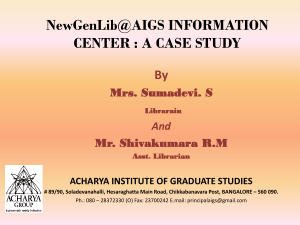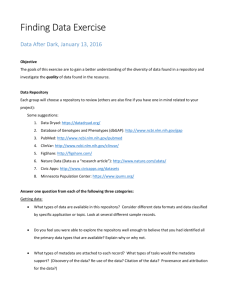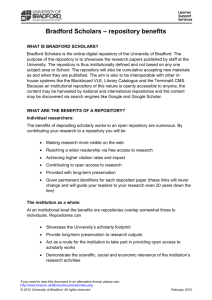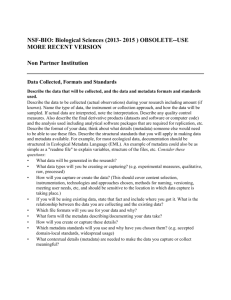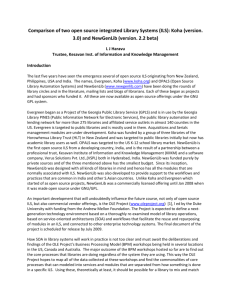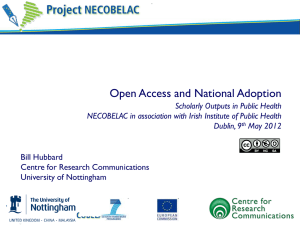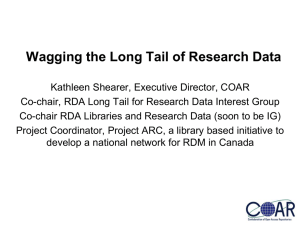The Development of Institutional Repositories using the NewGenLib
advertisement
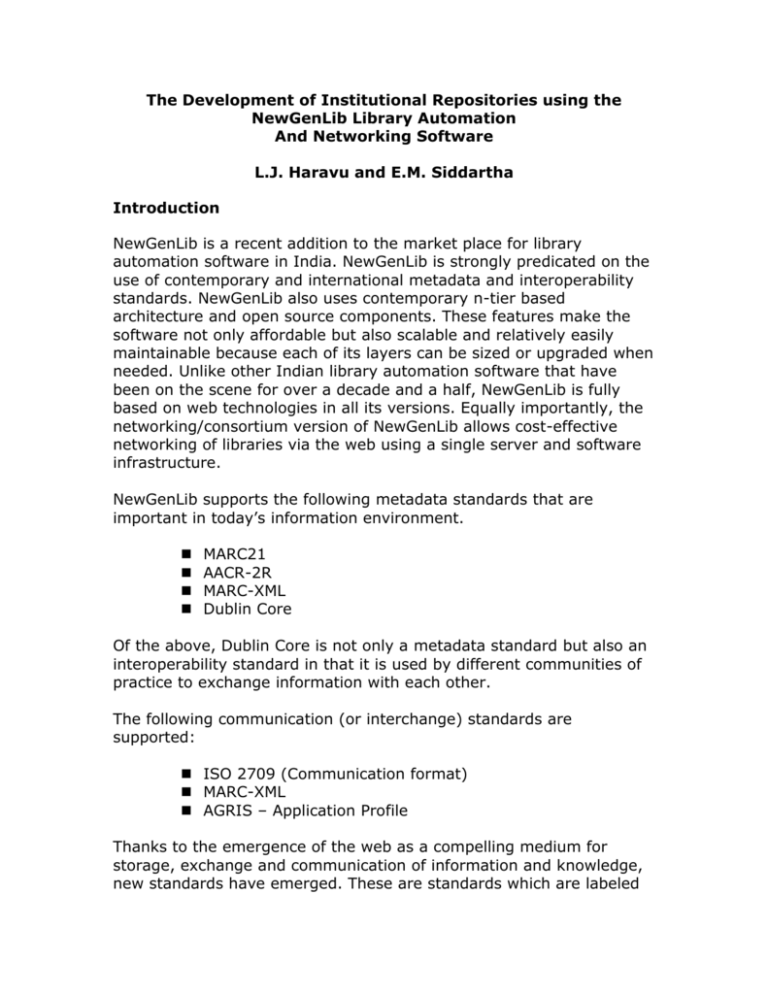
The Development of Institutional Repositories using the NewGenLib Library Automation And Networking Software L.J. Haravu and E.M. Siddartha Introduction NewGenLib is a recent addition to the market place for library automation software in India. NewGenLib is strongly predicated on the use of contemporary and international metadata and interoperability standards. NewGenLib also uses contemporary n-tier based architecture and open source components. These features make the software not only affordable but also scalable and relatively easily maintainable because each of its layers can be sized or upgraded when needed. Unlike other Indian library automation software that have been on the scene for over a decade and a half, NewGenLib is fully based on web technologies in all its versions. Equally importantly, the networking/consortium version of NewGenLib allows cost-effective networking of libraries via the web using a single server and software infrastructure. NewGenLib supports the following metadata standards that are important in today’s information environment. MARC21 AACR-2R MARC-XML Dublin Core Of the above, Dublin Core is not only a metadata standard but also an interoperability standard in that it is used by different communities of practice to exchange information with each other. The following communication (or interchange) standards are supported: ISO 2709 (Communication format) MARC-XML AGRIS – Application Profile Thanks to the emergence of the web as a compelling medium for storage, exchange and communication of information and knowledge, new standards have emerged. These are standards which are labeled as interoperability standards and are meant to help library and information systems to exploit the highly distributed nature of web resources. These standards allow disparate software using one or other platform (Windows, Linux, etc.), one or other database backend (MS-SQL Server, MySQL, PostgreSQL) and residing on a network anywhere in the world but connected to the Internet, will be able to exchange information with each other and/or search each others databases seamlessly without any barriers. The interoperability standards that NewGenLib supports are: SRU/W OAI-PMH These are web services standards in that they use simple web protocols and implementing these does not require extensive programming. SRU/W is a protocol for federated searching while OAIPMH is a protocol that is the bedrock of the Open Access (OA) movement. It is a protocol that all institutional digital archives (or repositories) are expected to support so that harvesters can draw information from each other in enriching their databases. Because of the rising interest worldwide in the development of OA repositories, two well known open source software, viz., Dspace and Eprints have been developed to enable various kinds of institutions to develop and host their OA repositories on the web. In effect a library wanting to take the initiative to develop OA repositories of their institution has to use two separate applications: one for library management, and another for developing and maintaining OA repositories. At NewGenLib we decided that we would provide the needed functionality so that with a single application both objectives are achieved. In this paper, we explain how NewGenLib, primarily a library automation software, can be used also for developing institutional digital libraries of open access materials. Database development in NewGenLib Bibliographic databases under NewGenLib comply with the MARC-21 format. By this we mean that MARC-21 bibliographic data can be easily imported into NewGenLib data structures and also that data within NewGenLib data structures can be exported as MARC-21 records. In addition to support for bibliographic data, NewGenLib also supports the MARC-21 format for Authority and Holdings data. This enables libraries using NewGenLib not only to describe bibliographic data for all kinds of material types using the MARC-21 and AACR-2R standards, but also ensure that internal authority files (for personal and corporate names, subject terms, series titles, geographic names, etc.) is maintained to ensure consistency and accuracy in records. NewGenLib provides for three levels of detail in cataloguing: a minimal level using a simple template; a mid-level of detail using a general template; and the capability to enter as detailed cataloguing data as will be permitted by the MARC-21 standard by using the MARC-21 template. Irrespective of the level of detail with which the data is entered, records are stored as MARC-21 records in the NewGenLib database. In NewGenLib, when creating the metadata for an item, it is possible to designate it as belonging to the institution’s open access collection. This is done simply by clicking the checkbox for open access provided in each of the cataloguing templates. This is shown in figure 1 below. Cataloguing template Once a document (a monograph, chapter in a monograph, journal article, audio or video clip, etc.,) is designated as an open access item, it is described like any other item using one or other of the templates in NewGenLib. However, it is usual for an open access item to be available as a full-text item. The full text of such items available locally are then browsed and attached to the metadata record. The screen below shows how digital objects (full text, audio, video clips and images) can be attached to a metadata record. Attachment of digital content When the record is saved to the database, it becomes accessible in two ways to users: 1. via the web based online public access catalogue (OPAC), and 2. via an OAI-PMH compliant harvester Access via the OPAC retrieves the metadata and also shows that there is a digital object associated with the record. A user can then view the digital object on clicking the icon for the digital resource. The NewGenLib OPAC thus allows integrated access to open access items as well as other resources in the library. Data Providers and Service providers The Open Access community comprises two kinds of players: Data providers and Service providers. A data provider is an institution that exposes their metadata in a repository accessible on the web with the metadata either structured as basic Dublin Core or as other structure which can be easily restructured into Dublin Core by a harvester. A harvester is a suite of computer programs which issues http commands or queries to an OA repository expressed as a URL. Service providers are information centres who harvest data from other OA repositories and using the data so harvested, provide search and other subject portal services to their clients. A library or information centre today can act both as a data provider and service provider. An example of a http request to a NewGenLib OA repository is: http://ngl.icrisat.org/newgenlibctxt/oai2.0?verb=ListRecords&metadataPrefix=marc21 The request shown above asks the repository (in this case the NewGenLib ICRISAT repository) to list records in the repository. The request also specifies that the records in the repository use MARC-21 as the metadata standard. Response to requests are in the form of XML records. The harvester interprets the XML response and then displays the harvested items to the user. The process is shown in the figure below. Harvested records OAI-PMH Harvester Internet Request Request NewGenLib OA Repository Repository Response XML records NewGenLib allows a library to function both as a data provider as well as a service provider. The creation of open access records in NewGenLib and the hosting of a NewGenLib database on the public domain site, exposes these records to harvesters. Once a library creates its OA repository, it can be registered with the www.openarchives.org and this fact can be made known to institutions who might benefit from such a repository. NewGenLib’s database development module has an option to connect to other open access archives and harvest metadata records from one or more archives. This feature allows a library that uses NewGenLib also to become a service provider. The following features of the OAIPMH protocol are supported by NewGenLib. The listing of sets in an archive. If an archive has categorized its open access collections into sets, these are shown to the user. The listing of records within a set. Once a user selects a set, he can then list all the records within the selected set. The idea is by looking at the record’s metadata, the user (service provider) can decide to harvest the record. In NewGenLib, the harvested record becomes available for editing with any of the cataloguing templates. The edited record can then be saved to the local database making it accessible via the OPAC. The digital object associated with the record is seen as an icon and links to the object on the repository of the site from which the metadata was harvested. Resumption tokens. These are session-based identifiers which are used to tell the archive the start and end records that need to be harvested. The OAI-PMH protocol provides elaborate and alternative methods for harvesters to communicate with repositories to specify the from and/or to parameters when harvesting records. The resumption token comes into play when a harvester is harvesting several records at a time. In the event of a failed session, the resumption token comes into play. In NewGenLib, support to Resumption tokens is not as elaborate since the software harvests one record at a time. Conclusion NewGenLib is probably the only library automation software that allows a library to manage its internal housekeeping routines such as acquisitions, serials control, circulation, etc., but also to create and host an institutional open access repository. NewGenLib also allows libraries to serve both data provider and service provider functions. It is not necessary for libraries that use NewGenLib to learn to use two software programs, one for library management and another for the creation of digital open archives. These features, it is hoped, will improve the capacity of libraries to take a more proactive role in the emerging digital library scenario.
